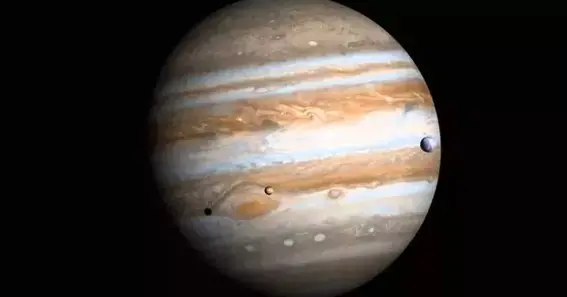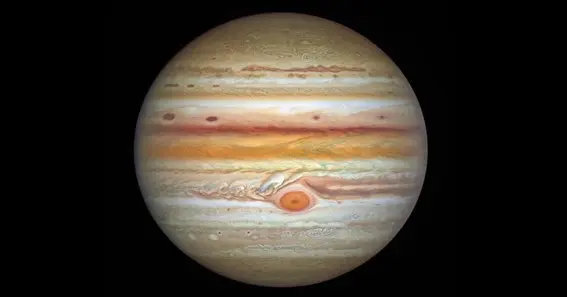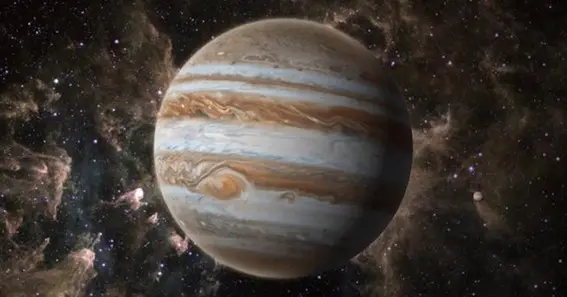What color is Jupiter? Jupiter is shades of green, yellow, brown, red, and orange. Jupiter has the most enormous mass in the solar system. They and stargazers have been fascinated for years. Jupiter’s size and strangeness set it apart from other planets in the night sky. Not only what color is Jupiter learn about the exciting processes that give Jupiter its beautiful range of colors and try to figure out how they work.
What Color Is Jupiter?

Jupiter shows different shades of orange, red, yellow, and green which may seem like a brilliant white star at night from afar. Viewing the world via a telescope reveals its beauty. The bright rings around Jupiter and go to its center stand out. You can see a lot of different colors in these bands. They run from bright orange and red to brown, yellow, and white. Each band shows a different part of the sky because the chemicals and types of clouds are different.
Jupiter’s colors are constantly changing because they are always making more. Intense storms, jet streams, and other things continuously move around in the Earth’s atmosphere. The weather changes the colors of Jupiter’s bands, a beautiful show of shapes and colors that are continually evolving. As you know what color is Jupiter but why does it have such vibrant colors?
Why Does Jupiter Have Such Vibrant And Diverse Colors?

Did you know what color is Jupiter and where do these beautiful colors come from? Jupiter’s bright colors come from the chemicals it has and the way its air moves. The leading gases in its atmosphere are hydrogen and helium. Small amounts of phosphorus, sulfur, and ammonia are also there, and they help make the bands look so bright. Jupiter appears white from Earth, but when seen through a lens, it is full of colors. We must learn more about these colors to understand how gas giants move. They help us learn more about the atmosphere of Jupiter, how chemicals mix, and how other planets behave.
Composition Of chemicals
Gases like helium and hydrogen comprise most of Jupiter’s atmosphere and more than 99% of the planet’s mass. In the last 1%, there are basic atoms and chemicals such as oxygen, nitrogen, carbon, phosphorus, methane, and ammonia. They change the colors of the world and the way the air moves around it.
Atmospheric Bands
Jupiter’s surface is beautiful because of the clouds and different chemicals in its atmosphere. Because these bands are in the Earth’s atmosphere, it’s hard to explain how they move in a way aligned to the equator. Some of these are jet streams, convection, and advection. Because of jet streams and storms, these bands, across from the equator, change constantly. Sunlight changes the colors of things in the air to red, brown, yellow, and white.
Colour changes
The rings around Jupiter are bright and change color over time. Changes in the weather, such as storms and earthquakes, cause them to grow and change constantly. This is why the beautiful patterns and colors on Earth’s surface come from the fact that things are continually changing.
Sunshine Effects
Jupiter’s many colors come from how sunlight mixes with the chemicals in its atmosphere. Different types of matter on Earth absorb and reflect various kinds of light, which gives the planet’s weather bands their bright colors.
Viewing with Telescopes
At first glance, Jupiter might only look white, but its bands of the atmosphere are full of color and interesting shapes. Astronomers know more than ever about Jupiter’s colors thanks to imaging methods like spectroscopy and polarimetry. That’s also how they learn a lot about what’s in Jupiter’s atmosphere and how it moves.
Role of Chemical Elements
Each color in Jupiter’s atmosphere comes from phosphorus, sulfur, and ammonia crystals. The Sun is very powerful, so these elements react chemically and photochemically to change the look of the planet’s surface.
Comparative Analysis
By looking at Jupiter’s colors, we can learn much about its atmosphere and how it moves. They can also help us figure out how Jupiter stacks up against other gas giant planets in the solar system. Planets take time to grow and change. Scientists can learn more about this by looking at the patterns and shapes in Jupiter’s atmosphere and the atmospheres of nearby planets.
Scientific Research
Many experts who study how other planets’ atmospheres work need to know about Jupiter’s colors. Why do Jupiter’s colors work? That will help scientists learn more about how our solar system came to be and whether there is life in other worlds.
Conclusion
The answer to what color is Jupiter? Is that it has a beautiful range of colors, from bright oranges and reds to yellows, greens, and browns. These colors come from the planet’s complicated atmosphere and changing weather patterns. This beautiful show is made when sunshine interacts with chemicals such as hydrogen, helium, phosphorus, sulfur, and ammonia. Seeing these colors through binoculars helps us learn more about how Jupiter’s atmosphere works and what its role is as a gas giant. By studying Jupiter’s bright colors and how its atmosphere behaves, scientists learn a lot about how the planet formed, how it has changed over time, and how it might be similar to other things in the solar system.
Jupiter’s diverse colors are a result of complex atmospheric phenomena, making it one of the most visually captivating planets in our solar system.
FAQ
How come Jupiter looks white from Earth?
Jupiter looks like a bright white spot in the sky at night because its clouds bounce light back into space, making it look very far away.
What’s the deal with Jupiter’s red spot?
Scientists think that sulfur and phosphorus mixing with chemicals and how the atmosphere moves makes Jupiter’s anticyclonic storm continuous.
Is it true that Jupiter’s color changes over time?
Jupiter’s atmosphere occasionally changes color, like when the seasons change or new clouds form.
Are there places on Jupiter that are known for having specific colors?
Yes, Jupiter’s warm and mild parts often have more colors than cold ones. In these spots, the particles and flow of Jupiter’s atmosphere are different.
How do experts see Jupiter’s colors?
From space, scientists observe Jupiter using spectroscopy, telescopic pictures, and computer models to determine its colors and how its atmosphere works.
Does Jupiter’s Color Change Over Time?
Yes, Jupiter’s colors can change due to variations in its storms, atmospheric activity, and chemical composition. Observations over decades have shown shifts in brightness and color intensity.
Check out more here for more interesting posts ashley-gutermuth-age/
Sources:
https://www.universetoday.com/15152/color-of-jupiter/
https://coolcosmos.ipac.caltech.edu/ask/104-What-color-is-Jupiter
https://www.spacecentre.nz/resources/faq/solar-system/jupiter/colour.html










